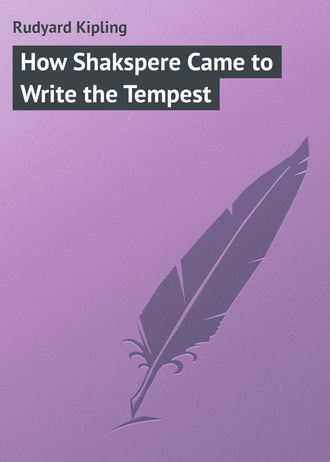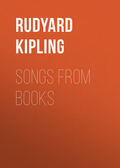
Редьярд Джозеф Киплинг
How Shakspere Came to Write the Tempest
If Shakspere’s mind was directed again to romantic themes and situations by the success of Beaumont and Fletcher’s plays, the clearest evidence of his indebtedness to them is to be found in his ‘Cymbeline’, which has many marked similarities to their ‘Philaster’. In his two plays which follow, the ‘Winter’s Tale’ and the ‘Tempest’, there is no detailed resemblance to the romantic tragic-comedies of the younger men. Shakspere, as well as they, had the whole tradition of romantic drama to draw from, and in particular he had his own past practice. He did not need to be shown how to depict romantic love, or charming heroines, or ardent suitors. For drinking scenes, like those of Trinculo and Stephano, or for dialog like that not very witty one of Gonzalo and the courtiers, he had many passages in his own plays that served as guides. Moreover, if ‘Cymbeline’ is an example of only partially successful experimentation with new methods, the ‘Winter’s Tale,’ and still more, the ‘Tempest,’ seem to me triumphant and unguided excursions of his own in the new field. But I think that Shakspere was attracted to this field by contemporary stage-successes, and that in seeking for novel and invented plots, in the contrast of tragic and idyllic elements, in the unusual and rapidly shifting situations, in the loose and parenthetical style, and in the elaboration of the dénouement, he was adapting himself to the new formulas and fashions in which Beaumont and Fletcher were the leaders.
Still another suggestion came from the theater, but this time from the court. The court shows of the sort which we have noticed as characteristic of the early years of Elizabeth’s reign had given place to a better ordered and more sumptuous spectacle, the Court Masque. Under James I, with the great architect Inigo Jones to devise the machines and setting, and with Ben Jonson to write the librettos, one of these masques was a magnificent affair. It was given on festal occasions at court and often cost thousands of pounds. It had but a single or at most two performances, always at night, and it came to follow a distinct formula. The kernel of the show was the masked dance in which members of the court, even King and Queen, took part. This dance or “masque proper,” often elaborated into several measures, came near the end of the show. As accompaniments there were (1) music, instrumental and vocal, (2) a play of some length, usually with mythological or allegorical motive, (3) various grotesque dances by professional performers, preceding the main masque and often integrated with the play, and (4) a spectacular stage-setting.
These shows were given in great halls, brilliantly lighted. The stage was splendidly decorated. Gods and goddesses floated among the clouds, and elaborate machines and scenes were devised. In one masque, a few years before the ‘Tempest,’ “an artificial sea was seen to shoot forth over the stage as it flowed to land, [this was the main machine – a great stage four feet high on trestles] on which was a great concave shell like mother of pearl” containing the masquers and conveyed by many sea-monsters hidden by the torch-bearers. The costumes of the masquers were in brilliant colors and heavily jeweled. These were often bizarre; but Inigo Jones knew the monuments of classical antiquity and the artistic achievements of Renaissance Italy as well as Jonson knew classical and humanistic literature. The living pictures were often in richness and color no unworthy rivals of the frescoes with which Rubens had decorated the ceiling of the Masquing Hall.
Such expensive spectacles were beyond the reach of the professional theaters, but contemporary dramatists frequently found something that could be adapted or imitated for the public stage. So the antick dance of satyrs in a ‘Winter’s Tale’ (three of whom are announced as having already appeared before the King) seems borrowed from an anti-masque in Ben Jonson’s ‘Masque of Oberon.’ In two plays of nearly the same date there is a well defined effort to combine the masque and the regular drama into a distinctive and novel dramatic entertainment, in the ‘Four Plays in One’ of Beaumont and Fletcher and the ‘Tempest’ of Shakspere. The ‘Tempest’ has always been a spectacular play on the stage, and so it must have appeared to him – and as a spectacle having many of the features of the court masque.
There is music and song. Ariel, Prospero, and even Caliban are proper figures for a court show. The “masque proper” is used to celebrate the betrothal in the fourth act. This is a simplified form of such a masque as would be given at court. There is evidently some machinery – it is the insubstantial pageant that calls forth Prospero’s famous lines. Ariel, Iris, Ceres, and Juno appear, Juno descending from the heavens. There is music and a song, and Ferdinand cries:
This is a most majestic vision, and
Harmonious charmingly. May I be bold
To think these spirits?
And when Prospero says they are spirits summoned by his art, Ferdinand exclaims
Let me live here ever;
So rare a wond’red father and a wise
Makes this place Paradise.
It is not Miranda now, but the machine and costumes used in court-spectacles that turn the platform into a land of romance.
Then enter Nymphs, “Naiads of the winding brooks with sedg’d crowns,” and Sun burnt Reapers, “with rye-straw hats.” These are the main masquers and join in a graceful dance, until upon Prospero’s sudden start – “to a strange, hollow, and confused noise, they heavily vanish.” More ingenious is Shakspere’s use of the anti-masques – i.e. dances by professional performers drest in fantastic costumes as animals, satyrs, statues, witches, etc. Such are the several strange shapes of III.3, who first bring in the banquet and again enter “and dance with mocks and mows and carrying out the table”; and in IV.1, the divers spirits who “in shape of dogs and hounds” hunt about the drunken conspirators while Prospero and Ariel set them on.
For a stage, then, that had long been used to romance, Shakspere planned a new wonderment. For it he revived some of his old creations from Illyria and Arden, and Fairyland, all transformed by
a sea change
Into something rich and strange.
And he added some excitements and novelties to keep pace with the thrilling tragi-comedies of Beaumont and Fletcher. And just as years before, in the ‘Midsummer Night’s Dream,’ he had drawn hints from the court entertainments by children, so now he conceived a spectacle that – so far as was possible – might rival the great shows of the Jacobean court. He did not need to go beyond the drama to find abundant suggestions for his new venture.





